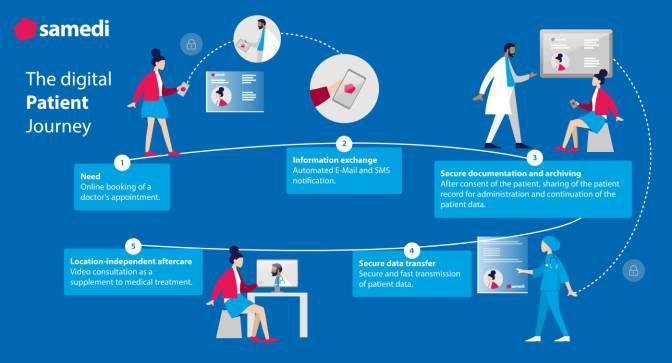
5 minute read
Katrin Keller


Advertisement

The Impacts of Pandemic in Pharma and Biotech Laboratory
The Coronavirus disease 2019 (COVID-19) was and is a world-changing event that has touched the lives of everyone on the planet, but on a positive note, it was an accelerant of technology and has forced companies to innovate. Companies that can do it better, faster, cheaper, more efficient, and have more creative approaches to problem solving will leapfrog to the forefront of the industry. We will see more of a focus to develop and implement technology that can deliver transparent, secure, and reliable data sharing remotely.
When COVID-19 was declared a pandemic, the industry rapidly responded with efforts put into place to effectively protect patient safety in their trials. Across the world, clinical trials answering important healthcare questions were stopped, or temporarily paused to possibly restart later, some with important modifications. Pharmaceutical companies and clinical research organizations greatly felt the effects of the COVID-19 outbreak on the clinical trial life cycle and began to incorporate remote ways of working to mitigate disruption. Over the last decade, regulators have been advocating for greater use of technology, virtual trials, and SMART trial designs. In the era of COVID-19, ongoing studies were now faced with new challenges like site closures, quarantines and limited access to study documents. As a result, clinical study teams are now relying heavily on remote monitoring and a more secure means of document sharing in order to meet clinical study timelines. As a laboratory solution developer for the Pharma and Biotech industry, it's important to highlight this background as an important framework which provides a basis for the direct impact of the COVID-19 era on the bioanalytical business today as well as providing insight of what the lab of the future needs to become. For example, direct impact for the laboratory when pharma companies moving toward more efficient SMART clinical trial adaptive designs, which allows for the continual modification of the trial based on interim data, is that in in addition to help in shortening development time, such designs may reduce the total sample size needed thereby reducing the number of samples that would need to be analyzed by the laboratory. So, in a business very much driven by the number of samples to be analyzed, when trials are delayed or producing much less samples, labs have to pivot more towards a focus on other activities such as the emerging market for biomarkers in order to fill the void from lost sample count to analysis types that would generate the same revenue.
In addition to evaluating different business strategies, labs need to be able to have access to information technology to be able to manage operations more efficiently including managing all processes remotely. In order to be effective, everyone needs to be well versed and comfortable using this technology. Use of disconnected spreadsheets or non-database sources are
no longer a viable option because they are problematic for real time sharing of information. Despite the significant investment that pharma has made in technology, the #1 problem still facing the scientist today is “Finding data when I need it”. Historically, technology has focused on just replacing the existing paper process with electronic counterpart. We must ask ourselves, are we going to continue to build tools to support existing business models and existing ways of working or should we begin to think about tools to reinvent the way we do business?
Labs have now learned that they can and must work remotely for many tasks without significant impact on performance. Roles relating to project management particularly fit this new paradigm very well but only if the tools to do so are in place and folks are comfortable with using them. The upside is improved quality of life for staff who can significantly reduce commute time, stress and costs. Time gained can be re-invested into actual work for clients and conducting more science. For the laboratory operations staff who are typically required to be on-site as “essential” lab personnel, in addition to adhering to typical lab safety requirements, new pandemic related items such as spatial distancing, masks etc have been included. Lab space available was the key driver to ensure this was achieved. But what we have learned is labs can actually reallocate space previously used by project management and other remote staff and even reduce their fixed costs on building office space etc needed by giving folks who can work remotely the tools and training to do so. Acting on both these learnings will only become more important depending on how long this pandemic lasts, and also as proactive preparedness for the next one. Perhaps we should already be building for this next phase? If non-essential folks can mostly work from home, how can we reduce the need for “essential” lab staff to work on site? Is the lab of the future one which places much less burden on needing so many scientists to be on site and instead leverages integrated operational robotics, machine learning and remote control of these laboratory systems?
Tools that enable a flexible business model, are cost effective, and allow for remote access will be in high demand moving forward and will allow us to get beyond just managing data more efficiently. This allows us the opportunity to start doing interesting things with that data. Technologies that facilitated the ability to do this have been brought to the forefront in lieu of the more typical investments of continually just adding more people and more instruments.
As virtual and remote working prove to be sustainable methods of laboratory operations, it is unlikely early adopters will revert back to the more laborious and timeconsuming methods involved in the previous, highcontact model. Consequently, companies will require comprehensive platforms that address their changing unmet needs and evolve their expectations of what an integrated ecosystem can provide. Having a good understanding of how much work is taking place digitally will accelerate the technology enabled remote work. At Metrendalytics, we have always recognized the value of online work situation and had the infrastructure in place to do so, therefore our operations did not skip a beat during these pandemic times.
While the new normal is still unfolding, it is becoming increasing clear that the future will be anything but normal. We will begin to see more decentralization, technology, and the need to make important decisions not at the office. It is always important to remember that during these times of disruption, uncertainty and challenge, those who can reinvent themselves and move forward will open a gateway to an abundance of opportunities.






